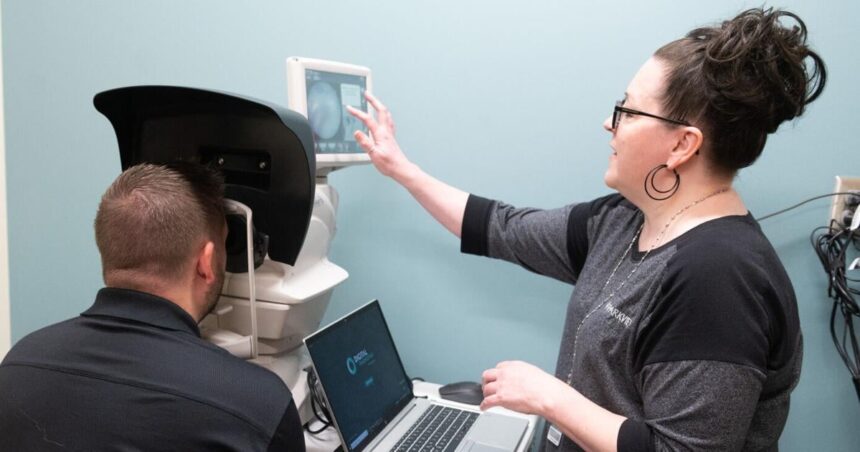Dr. Michael Grabowski was confident in his surgical abilities and thought he didn’t need help with his specialty, especially from a robot.
“I did thousands of surgeries,” said Grabowski, physician executive of Parkview Health’s surgery service line. “I was like, ‘I don’t need the robot. I can do the surgeries well, and my patients do well and leave the hospital feeling well.’ ”
Robotics is just one example of technology increasingly used to care for patients, local health care professionals say. Artificial intelligence, or AI applications, is also being incorporated in various ways.
Grabowski calls himself the “biggest proponent” of Parkview’s da Vinci Xi Surgical System – robotic technology that is fully operated by experienced surgeons in the operating room. The device, used at multiple system hospitals, allows him to see inside a patient’s body and perform operations with high precision.
Grabowski has worked at Parkview for 23 years, and he’s used the da Vinci technology since 2012.
The technology can help with various specialties, including gynecological, urological, cardiac and general surgeries, according to the Cleveland Clinic. Parkview announced in March that the health network started using it at its Noble hospital, making that its seventh location. The DeKalb hospital started using it last year.
Parkview has 16 da Vinci Xi surgical systems throughout the network. In addition, the Noble and DeKalb hospitals, the regional medical center, heart institute, Randallia, Whitley and Kosciusko hospitals use the system.
The health system also uses Globus and SeaSpine robotic technology for spine surgery and Depuy and Smith+Nephew robotic technology for joint surgery.
Traditional AI, generative AI
As AI becomes more advanced, health care professionals expect it to move into robotic surgical platforms, according to a March study from Springer Link’s Journal of Robotic Surgery. AI can improve surgical capabilities, and it’s used to automate tasks and enhance safety.
AI was first created in 1950, according to the National Library of Medicine, but limitations prevented widespread acceptance and application to health care. Now, AI can help improve diagnostic accuracy and workflow efficiency.
Dr. Mark Pierce, chief medical information officer for Parkview Health, said the network uses AI “every single day.”
“In the broadest of terms, it’s the foundation for some of the clinical models that help providers with predictions, early warnings, for clinical deterioration, for sepsis, for falls,” Pierce said.
Parkview is piloting programs with generative AI, Pierce said, which will help reduce administrative duties and burdens for providers. With generative AI, providers can spend less time inundated with paperwork and more time face-to-face with patients.
Not all AI is considered generative. Traditional AI is used for narrow, specific tasks, and generative programs focus on a broader range of capabilities, according to the U.S. Chamber of Commerce.
Generative AI creates new data, and Pierce said it can help health systems create new documentation. He said Parkview has to proceed with caution to ensure people’s privacy is still protected.
Although AI can be helpful in health care, Pierce said a stigma still exists around the technology.
Pierce said Parkview is committed to ensuring patient safety comes first, especially when working with more technology.
“It really gets to the core of who we are and what our role in the community is,” Pierce said. “It’s patients first, and it’s our community first.”
The technology eliminates patients’ trips to the eye doctor, where they can check for diabetic retinopathy in a dilated eye exam. Primary care offices can use the noninvasive technology and receive results in minutes.
“Early screening is the key to prevention,” Pierce said. “This tool is a great convenience for patients, and it’s a great benefit for patients, especially for those with limited access to other eye care professionals or the inability to travel to those appointments.”
The integration of more technology has a “great amount of promise” in the health care industry, Pierce said, and not just through AI.
Better robots, better care
While the da Vinci surgical system doesn’t use AI, Grabowski said technology in general has led to better outcomes in surgery. Robotic surgery has expanded in the last 10 years, he added.
Benefits of robotic surgery include shorter hospitalization, reduced pain and discomfort, faster recovery time, smaller incisions, reduced blood loss and transfusions, and minimal scarring, according to University of Cincinnati Health.
Dr. Emanuel Nearing II, a minimally invasive bariatric and general surgeon at Lutheran Downtown Hospital, works with similar da Vinci technology.
Nearing was initially hesitant to the technology, but he changed his opinion after watching it evolve and benefit patients.
“I wasn’t necessarily a naysayer,” Nearing said. “I was a later adopter of the robot because I did a classic, minimally invasive, traditional fellowship in bariatrics, so for a long time I didn’t think I needed the robot. I didn’t think it was going to add anything because I had good outcomes.”
When a new robot is released, the system is updated each time. Lutheran uses only da Vinci robotic assisted surgical technology.
“They take in the feedback of probably hundreds of thousands of surgeons working on cases all over the world,” Nearing said.
The minimally invasive technology allows Nearing to use five instruments at once, he said, and he can use only two without it.
Nearing said he also believes robotic technology benefits patients.
With the da Vinci, Nearing said, he has “relatively short operative times.” Patients also report less discomfort, so he prescribes far fewer narcotics for pain.
Patients are also discharged faster, Nearing said. Before using robotic technology, they would stay at the hospital for two nights to complete tests. Six of Nearing’s last seven gastric bypass-surgery patients spent one night in the hospital.
“When the downtown hospital opened and they said they were going to have a da Vinci,” Nearing said, “I started transitioning some of my more advanced cases over to the robotic platform because I felt it was going to allow me to better treat the patients.”
Possibilities for use ‘are endless’
Dr. Colin Linke, medical director of urology for Lutheran Health Network, uses robotic simple prostatectomy technology, which helps with partial or complete removal of the prostate.
Lutheran is one of three health systems in Indiana with the technology, Linke said. Parkview was the first health system in the state to have simple prostatectomy technology and the first to do that variation of surgery, Grabowski said.
Indiana University Health is the third system with the technology, at its hospital in Carmel.
“It took a lot of convincing (to get the technology),” Linke said. “But, I mean, at the end of the day, the data really speaks for itself about what this technology provides.”
Typically, the surgery requires about five incisions to complete. With the robotic technology, Linke said, surgeons need only one, and they can get closer to the pelvis, where the prostate is located. Patients also have a shorter recovery time.
“Using a smaller regionalized approach to get into those small spaces really has nothing but benefits for the patients,” he added.
“All of the outcomes that are side effects of surgery have been diminished due to the regionalization and not needing to work in such a broad space.”
Linke expects robotic technology to be used more in the future.
“The possibilities for all specialties are endless,” he said. “I think this is going to be beneficial for patients and the health care system.”











